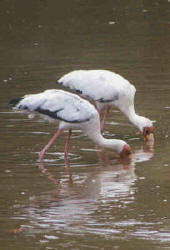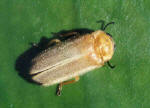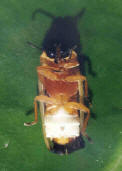Introduction
| |
 |
| |
View from the Main Hide across
the brackish lakes
|
Kuala Selangor lies just 75 kilometres north-west of
Kuala Lumpur, near the mouth of the Selangor River. In addition to it’s
small-town charms there are many nearby attractions to suit the nature
lover, including the Kuala Selangor Nature Park and the colonies of
fireflies living along tributaries of the Selangor River.
Kuala Selangor
The Kuala Selangor Nature Park is managed by the
Malaysian Nature Society, under a co-operative arrangement with the Selangor
State Government. This coastal area was once dominated by mangroves, but
since the construction of coastal bunds it now comprises a strip of remnant
mangrove forests, mainly Avicennia sp., behind which are brackish lakes and
ponds and a large area of secondary forest. In many respects the ecological
history of the area is similar to Singapore’s own Sungei Buloh Wetland
Reserve. Thus, familiar vertebrates such as mud skippers, mud lobsters and
the Malayan Water Monitor can be seen from the bund and the mangrove
boardwalks.
 |
|
|
The endangered Milky Stork
Mycteria cinerea - a captive breeding program is aimed at preventing
their extinction.
|
|
During the migration season, between September and
March, the lakes and ponds teem with shorebirds such as plovers, Greenshank,
Redshank and various species of sandpiper travelling the migration route of
the East-Asian Flyway. These very same birds may well stop at Sungei Buloh
for a final meal of worms and molluscs before heading south to winter in the
warmth of Australia.
One bird deserves a special mention – the Milky Stork.
In conjunction with Zoo Negara, an active breeding program of this globally
endangered species - less than 100 specimens are thought to exist - is being
conducted in a specially constructed aviary next to the main lake. Visitors
are not allowed inside the aviary, however the birds can clearly be seen
nesting in the enclosure. It is hoped, upon release, these captive-bred
storks will choose to make Kuala Selangor their permanent home.
Kuala Selangor Nature Park has over 200-hectares of
immature secondary forest. Easy walks are possible along the well worn
trails; where the sun streams through breaks in the canopy keep an eye open
for lizards and skinks warming themselves, especially the Common Sun Skink.
Familiar forest birds such as Woodpeckers, Bulbuls, Sunbirds and Malkohas
can also be seen.
| |
 |
| |
The Silvered Leaf Monkey or
Silvered Langur Presbytis cristata - common in the secondary
forest of Kuala Selangor Nature Park
|
Silvered Leaf Monkeys
One highly vocal species the visitor is likely to
hear, if not see, in the secondary forest is the Silvered Leaf Monkey, also
called the Silvered Langur. Troops of these large, grey-black, long-tailed
monkeys can be heard crashing through the trees, scaring away the more timid
bird species. In the same manner as trendy young people, the baby langurs
appear to have died their fur a startling bright orange colour; one wonders
how the adult monkeys cope with being the parents of such outrageous
offspring ! In the early morning the langurs raid the gardens of people
living at the base of Bukit Melawati, at the northern edge of the park,
searching for ripened fruits.
| |
|
 |
|
|
Well marked trails wind their
way through the secondary forest |
|
The mischievous Long-tailed Macaque, which is common all over Malaysia and
Singapore, appears to be less common here. Presumably, there is competition
for food and territory between the macaques and the langurs; the smaller
macaques must content themselves with living on the park’s boundaries.
Kelip-kelip Away from the Nature Park, branching
off the Selangor River are a series of narrower tributaries lined with
healthy stands of Beremban or Sonneratia Caseolaris. This tall mangrove
species is characterised by simple symmetric leaves, and cone-like aerial
roots. During the day this tree species might seem unremarkable, however as
dusk falls beautiful flowers open up, each with an array of up to 100
reddish-white stamens. In these quiet, ulu backwaters survive Pteroptyx
tener, the firefly species which makes S. Caseolaris their home.
| |
 |
| |
Pteroptyx sp. - the
beetle species known as "fireflies", or "kelip-kelip" in Malay.
|
At twilight, the kingfishers and bee-eaters give way
to nightjars and owls, and the fireflies, or "kelip-kelip" as they are
locally known, put on a dazzling light show. Thousands of these insects
commence their fluorescent display, flashing on and off two or three times a
second, some stationary, others circling around. In some trees a whole
colony of fireflies will flash in absolute unison, hour after hour, in the
manner of the lights on a Christmas tree. Male and female fireflies are both
able to flash, but only the males flash in unison; the synchronised display
serves to attract a mate, but how does the female choose her mate amongst
the thousands of "switched-on" males !
 |
|
|
Underside view of Pteroptyx
sp. showing the light-emitting abdominal segments
|
|
The dense colonies of fireflies were, in olden times,
used as a navigation aid in some rivers in Malaysia. As you view this
wonderful sight, lulled by the gently rocking boat and the quiet putter of
the engine, you fancy that thousands of years ago when the world was less
polluted, many rivers supported these wondrous insects. Imagine the awe of
primitive humans as they migrated down the Malay Peninsula thousands of
years ago and their eyes saw these flashing lights for the first time.
Now the fireflies can be easily viewed by modern
humans at Kampung Kuantan and Kampung Bukit Belimbing, both a short taxi
ride from Kuala Selangor town. At both locations tourist facilities have
grown in the last few years, so there are new jetties, reliable boatmen and
restaurant and toilet facilities. If you think that the commercialisation of
firefly viewing could in some way be a threat to their survival, think
again. Consider that a huge dam is proposed for the Selangor River.
Conservationists fear that the dam may affect water flow, river level and
salinity downstream, spelling doom for the fireflies. Opposition to the dam
is being loudly voiced, not only by environmentalists but also by those
kampung folk whose livelihood depends upon the tourist dollar. Thus, it may
be that the fireflies need the tourists in order to survive.
Next Christmas, instead of following the hordes of
people to view the annual light-up of Singapore's Orchard Road, why not take
a quiet trip up-country to view the unique, world-renowned fireflies of
Kuala Selangor. It will be an experience of a lifetime.
|